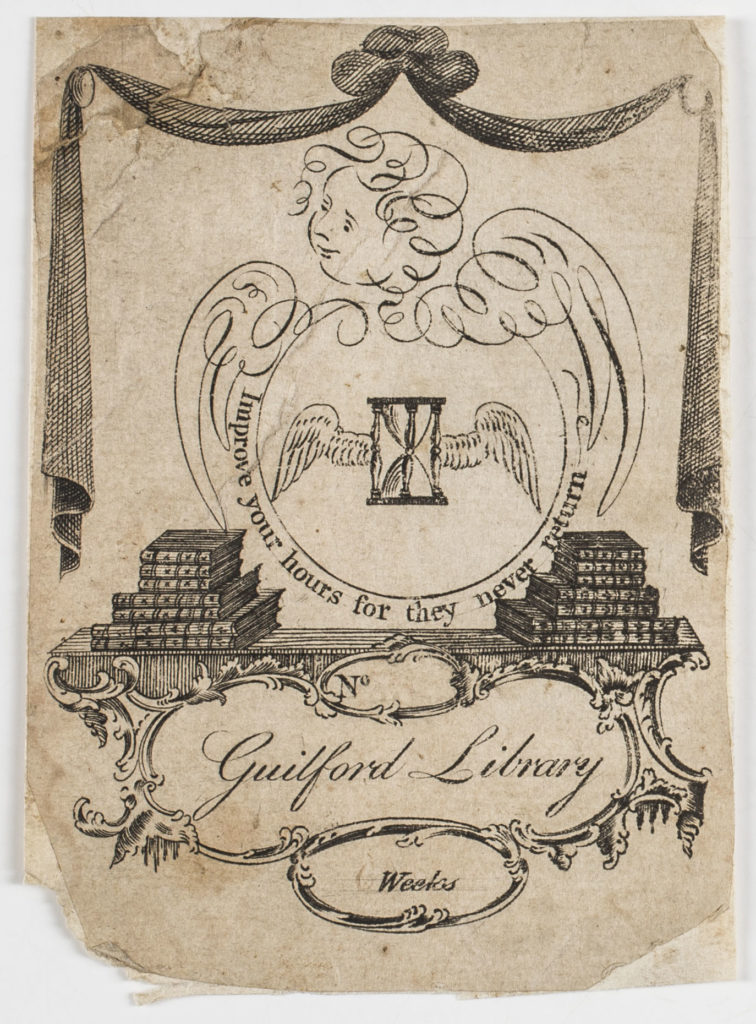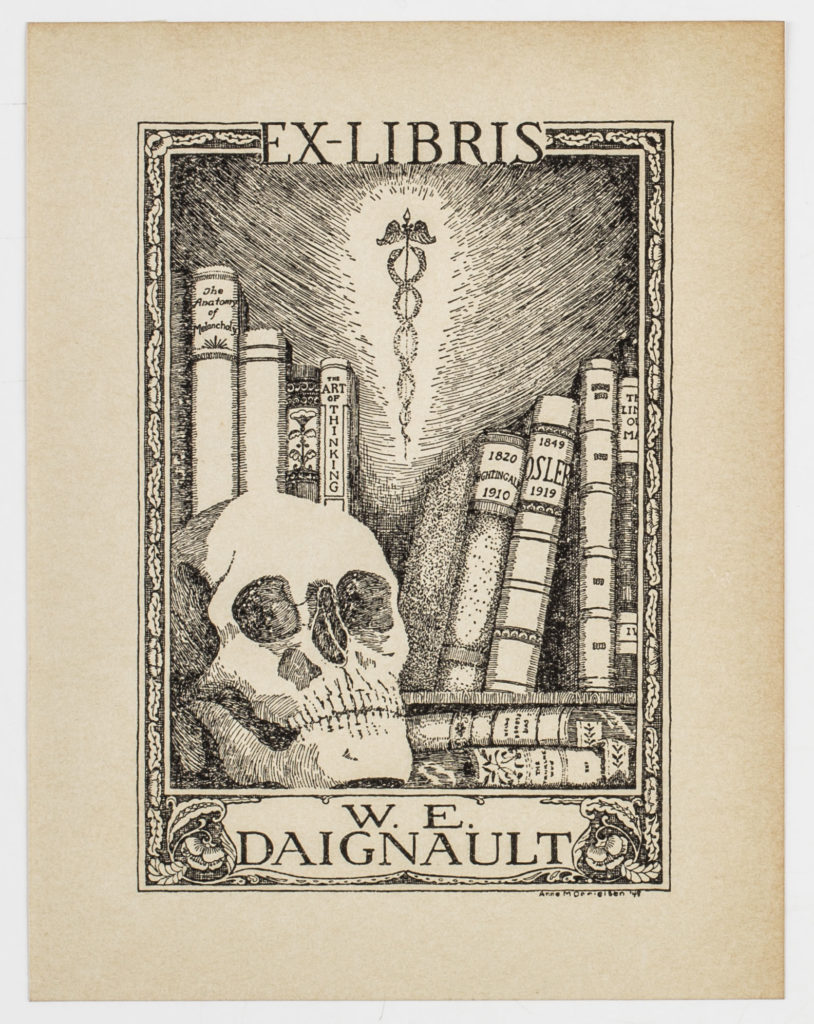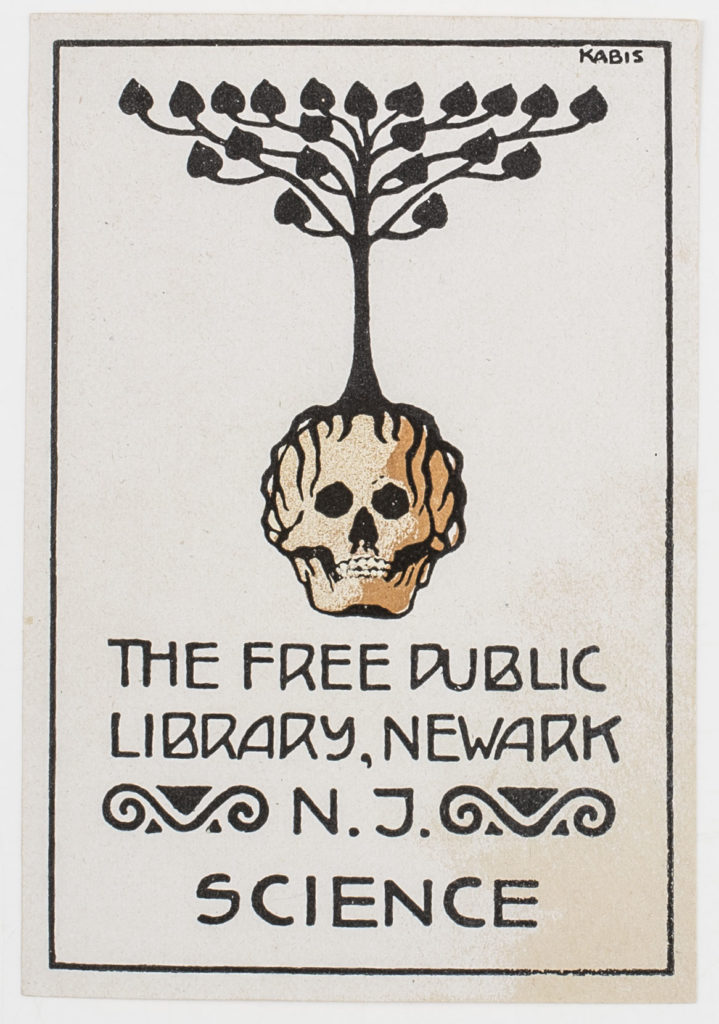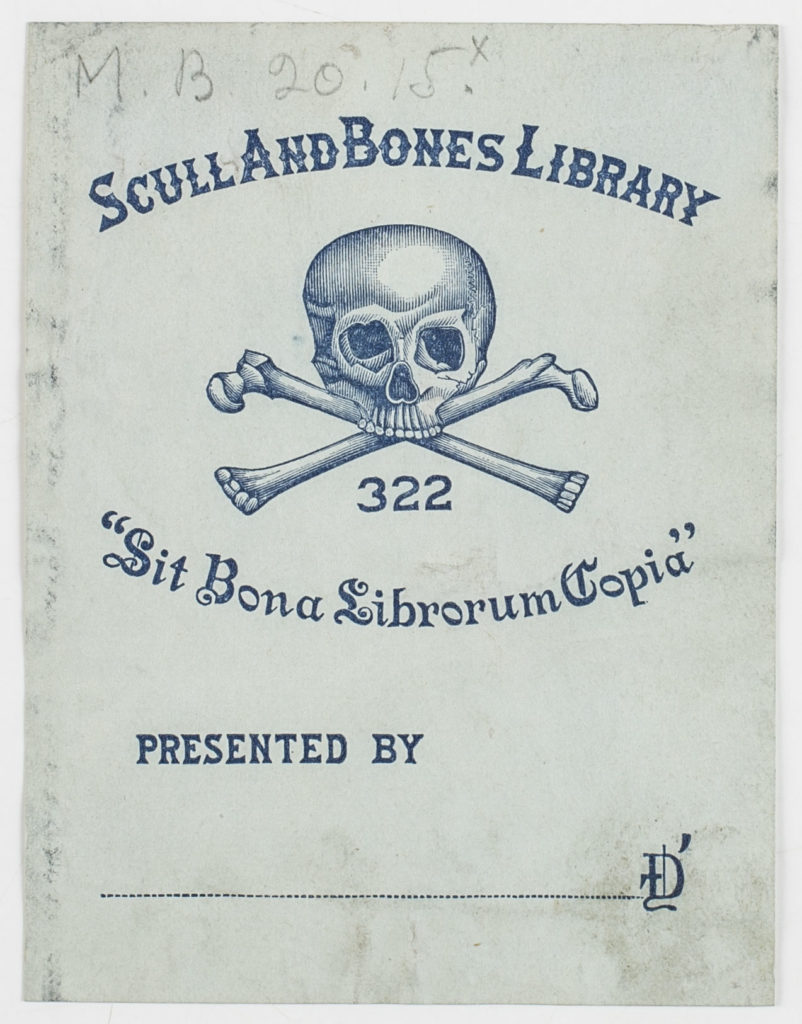Each year as Halloween comes around, the staff here at AAS tries to think of ways to feature the spooky, scary, and creepy material in the Society’s collection. We have shown off our postcard collection and some fright-inducing stereograph photos. We’ve hunted for ghost stories, featured gift book illustrations of the supernatural, and peered into the pale, icy eyes of old photographs.
This year, we decided to dive into our collection of ex libris. The Society has an outstanding collection of around 40,000 American bookplates, ranging in date from 1642 to about 1945. Although the collection is not digitized, you can see a small assortment of our plates via our Instagram account by searching there the hashtag #aasbookplates. Some plates in the collection are set in type; others are engraved or printed with relief blocks. There are lots of coats of arms, images of library interiors, names with elaborate flourishes, library rules, threats about damaging or forgetting to return books, and skulls. Wait, skulls? Yes, skulls.
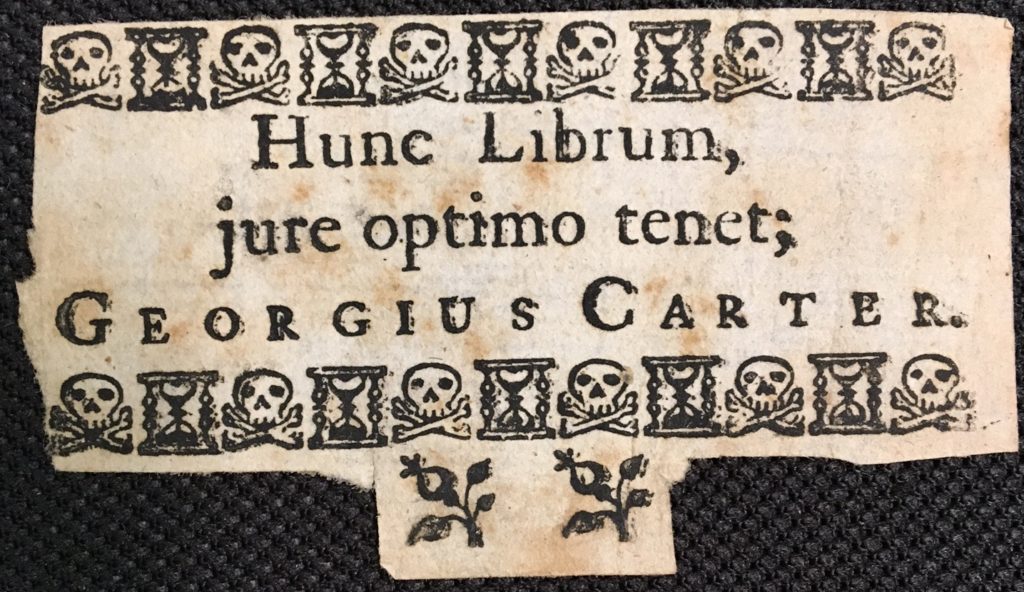 Symbolic memento mori images include skulls, corpses, skeletons, and hourglasses – all intended to remind mortals of their short time here on Earth. They are common on bookplates because of the popular eighteenth- and nineteenth-century belief that self-improvement by reading was a morally righteous way to spend one’s limited time (rather than gaming, carousing, or thieving, for example). One of the earlier plates in the collection that fits this mold is the type-set plate for George Carter, which was removed from a 1790 London edition of a translation of Justini’s Histori Phillippic. The Latin motto, Hunc Librum, jure optimo, tenet (which translates roughly to “This Book holds truth”), is surrounded by alternating rows of skull with crossbones and hourglasses.
Symbolic memento mori images include skulls, corpses, skeletons, and hourglasses – all intended to remind mortals of their short time here on Earth. They are common on bookplates because of the popular eighteenth- and nineteenth-century belief that self-improvement by reading was a morally righteous way to spend one’s limited time (rather than gaming, carousing, or thieving, for example). One of the earlier plates in the collection that fits this mold is the type-set plate for George Carter, which was removed from a 1790 London edition of a translation of Justini’s Histori Phillippic. The Latin motto, Hunc Librum, jure optimo, tenet (which translates roughly to “This Book holds truth”), is surrounded by alternating rows of skull with crossbones and hourglasses.
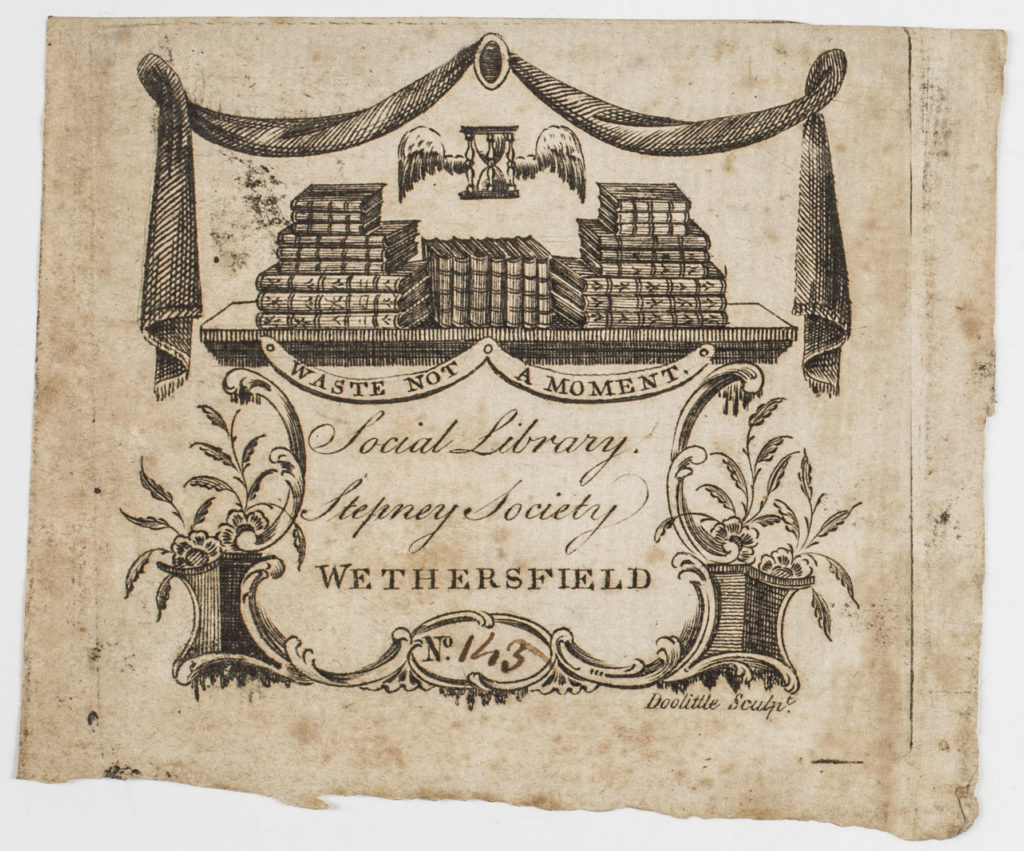 The hourglass is frequently used to illustrate the passage of time—something that can move quickly when a reader is absorbed in a good book—as well as something which is proscribed for human beings. The engraved plate for the Social Library in Wethersfield, Connecticut, was made around 1795. The artist, Amos Doolittle, included a winged hour glass and the motto “Waste Not a Moment,” encouraging the viewer to better themselves through books should they find themselves with free time. A similar design was used by an unidentified engraver for the Guilford [Connecticut] Library bookplate sometime around 1815, with a fluttering hour glass and the motto “Improve your hours for they never return.”
The hourglass is frequently used to illustrate the passage of time—something that can move quickly when a reader is absorbed in a good book—as well as something which is proscribed for human beings. The engraved plate for the Social Library in Wethersfield, Connecticut, was made around 1795. The artist, Amos Doolittle, included a winged hour glass and the motto “Waste Not a Moment,” encouraging the viewer to better themselves through books should they find themselves with free time. A similar design was used by an unidentified engraver for the Guilford [Connecticut] Library bookplate sometime around 1815, with a fluttering hour glass and the motto “Improve your hours for they never return.”
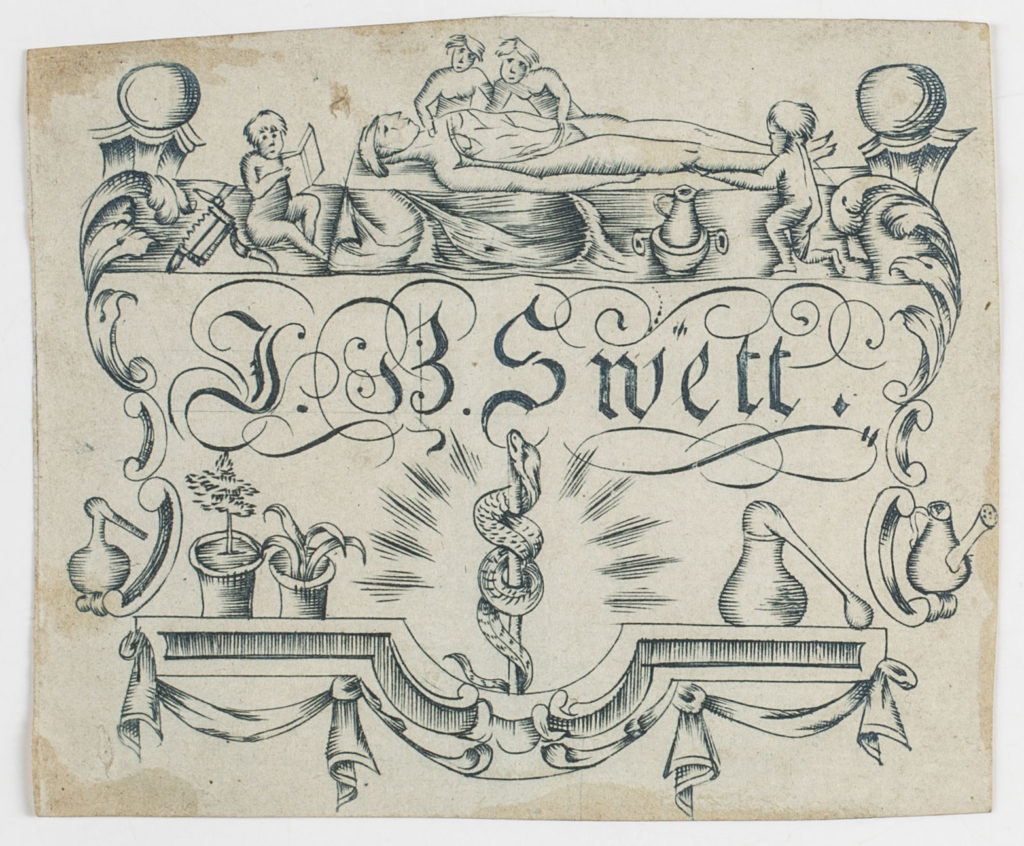 Not surprisingly, doctors frequently use memento mori images on their personal plates. The circa 1790 bookplate for Dr. John Barnard Swett of Newburyport, Massachusetts, includes glass retorts, herbs, a caduceus, and a corpse surrounded by putti and surgical tools. Death for Dr. Swett was likely not only a moment for reflection but also an opportunity for education. More than a hundred years later, the railroad executive, doctor, and book collector Frank Graef Darlington of Indianapolis,
Not surprisingly, doctors frequently use memento mori images on their personal plates. The circa 1790 bookplate for Dr. John Barnard Swett of Newburyport, Massachusetts, includes glass retorts, herbs, a caduceus, and a corpse surrounded by putti and surgical tools. Death for Dr. Swett was likely not only a moment for reflection but also an opportunity for education. More than a hundred years later, the railroad executive, doctor, and book collector Frank Graef Darlington of Indianapolis, 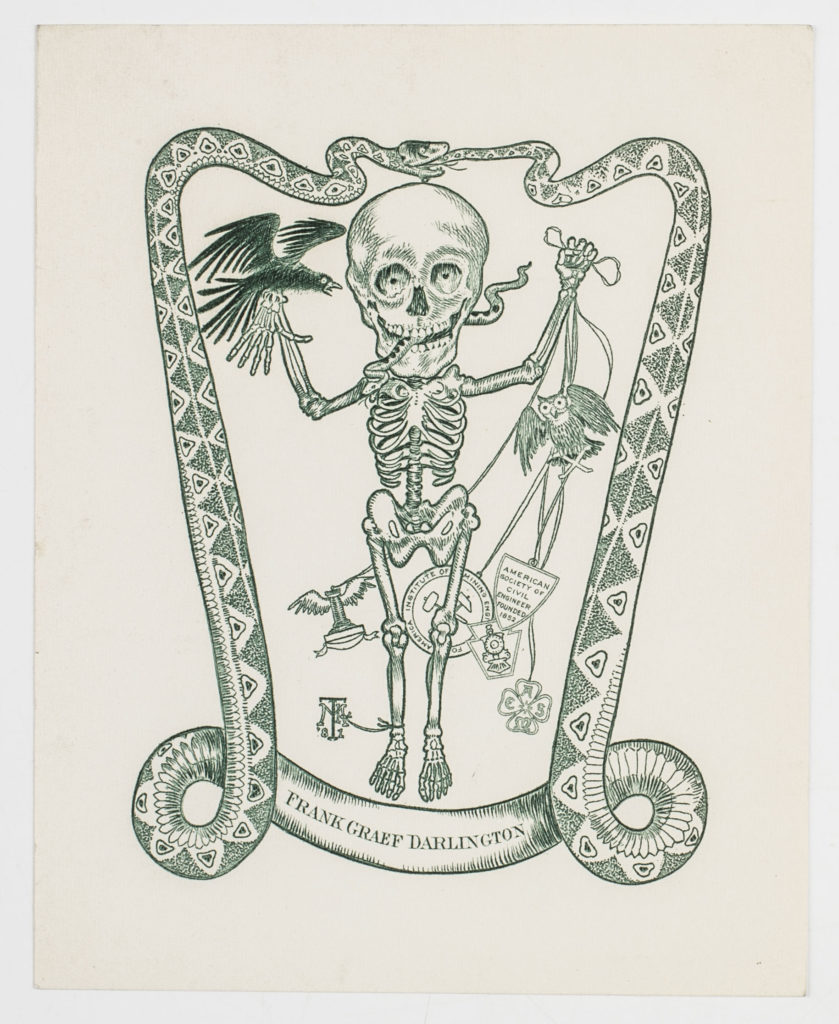 ordered a bookplate design from Frank S. Bowers, the famous cartoonist for the Indianapolis News. Bowers crammed in references to all of Darlington’s passions (engineering, mining, MIT) and surrounded a leering skeleton with a python border. Darlington struggled with health issues most of his adult life (suffering a debilitating stroke at age thirty-seven) and apparently had a wry sense of his own mortality. A fellow bibliophile commented that this particular bookplate was appropriate for Darlington as it held a “hideous and inexplicable fascination.”
ordered a bookplate design from Frank S. Bowers, the famous cartoonist for the Indianapolis News. Bowers crammed in references to all of Darlington’s passions (engineering, mining, MIT) and surrounded a leering skeleton with a python border. Darlington struggled with health issues most of his adult life (suffering a debilitating stroke at age thirty-seven) and apparently had a wry sense of his own mortality. A fellow bibliophile commented that this particular bookplate was appropriate for Darlington as it held a “hideous and inexplicable fascination.”
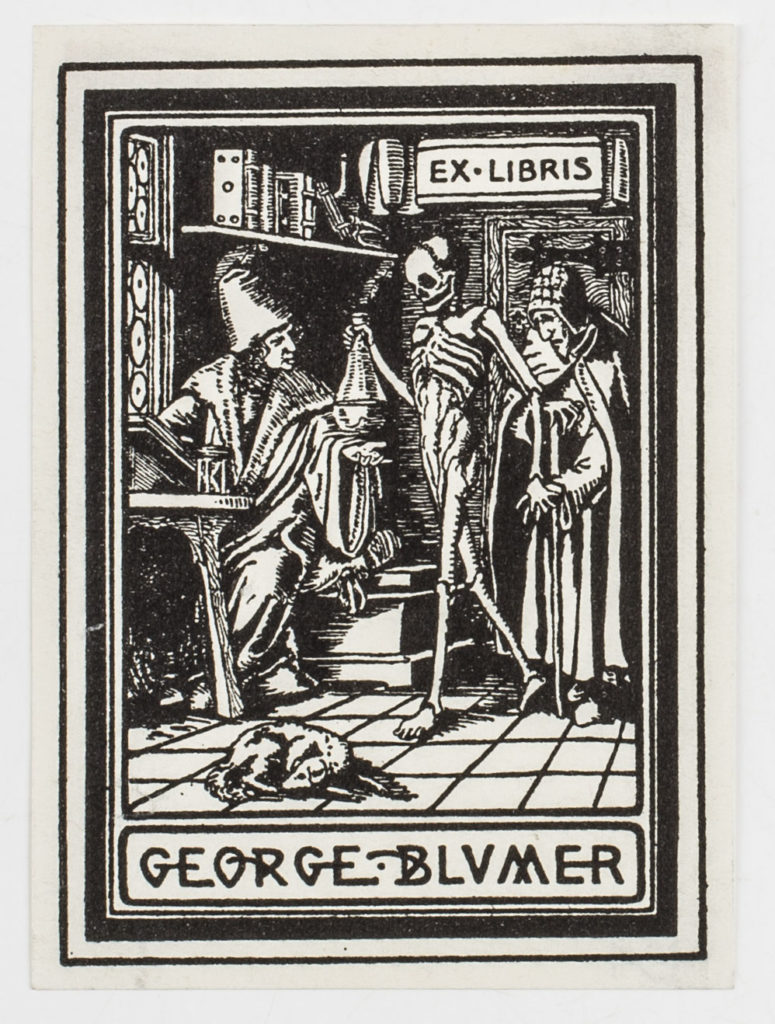 Doctors continue to use memento mori symbols on their bookplates well into the twentieth century. Dr. George Blumer, the dean of Yale’s Medical School, selected Hans Holbein’s well-known print from the 1520s, “Death and the Physician,” as inspiration for his circa 1910 bookplate. He even had the unidentified artist keep Holbein’s error: two bones in the upper arm versus one in the lower arm of the skeleton. In 1948, Dr. William E. Daignault had Californian artist Anne M. Danielsen etch his elegant bookplate (one of several that he commissioned) incorporating a caduceus, rows of medical books, and a human skull into the design.
Doctors continue to use memento mori symbols on their bookplates well into the twentieth century. Dr. George Blumer, the dean of Yale’s Medical School, selected Hans Holbein’s well-known print from the 1520s, “Death and the Physician,” as inspiration for his circa 1910 bookplate. He even had the unidentified artist keep Holbein’s error: two bones in the upper arm versus one in the lower arm of the skeleton. In 1948, Dr. William E. Daignault had Californian artist Anne M. Danielsen etch his elegant bookplate (one of several that he commissioned) incorporating a caduceus, rows of medical books, and a human skull into the design.
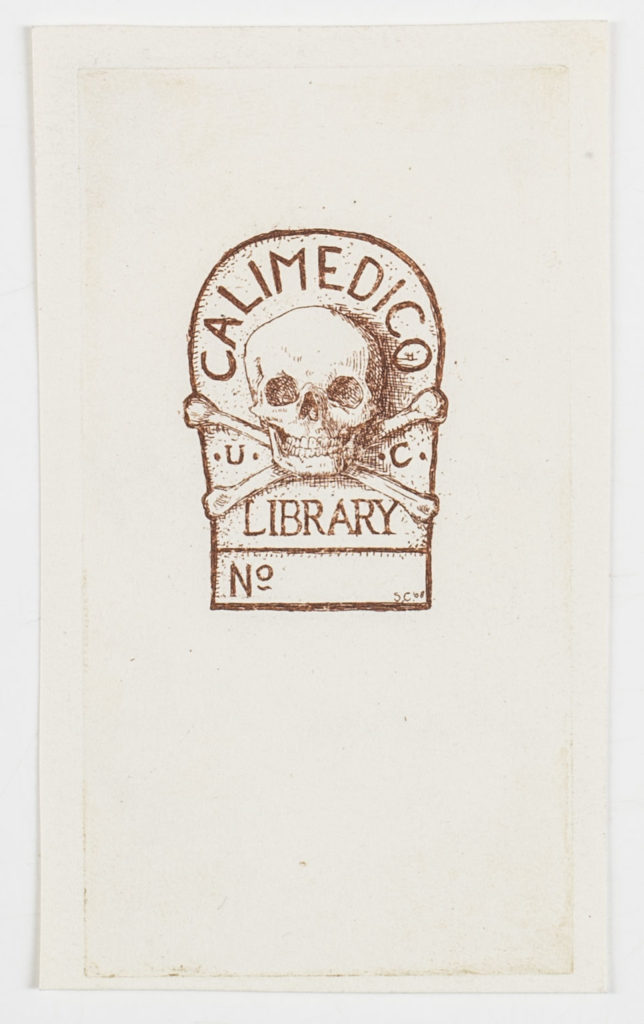 Not surprisingly, societies and organizations also feature skulls on their ex libris. In 1908, the Calimedico Club at the University of California, commissioned artist Sheldon Cheney to make their bookplate featuring a smiling human skull and crossbones. The Free Public Library in Newark, New Jersey, added a tree of knowledge to a skull for the plate used in their science collection. The Skull and Bones Society, a non-medical secret society founded in 1832 at Yale, used a skull without a lower jaw on their circa 1900 bookplate, along with the Latin motto Sit Bona Librorum Copia (“There are many good books”). The small library of the society was described in 1877 as being held in a bookcase on the second floor of their hall (known as The Tomb). It was made up of a complete set of Yale publications, handsomely bound college catalogs, and books published by members. Today it is known that the organization also holds an Aldine edition of Demosthenes and a first edition of Tristam Shandy. Unfortunately, it is not known how this bookplate ended up at AAS, or even the title from which it was removed.
Not surprisingly, societies and organizations also feature skulls on their ex libris. In 1908, the Calimedico Club at the University of California, commissioned artist Sheldon Cheney to make their bookplate featuring a smiling human skull and crossbones. The Free Public Library in Newark, New Jersey, added a tree of knowledge to a skull for the plate used in their science collection. The Skull and Bones Society, a non-medical secret society founded in 1832 at Yale, used a skull without a lower jaw on their circa 1900 bookplate, along with the Latin motto Sit Bona Librorum Copia (“There are many good books”). The small library of the society was described in 1877 as being held in a bookcase on the second floor of their hall (known as The Tomb). It was made up of a complete set of Yale publications, handsomely bound college catalogs, and books published by members. Today it is known that the organization also holds an Aldine edition of Demosthenes and a first edition of Tristam Shandy. Unfortunately, it is not known how this bookplate ended up at AAS, or even the title from which it was removed.
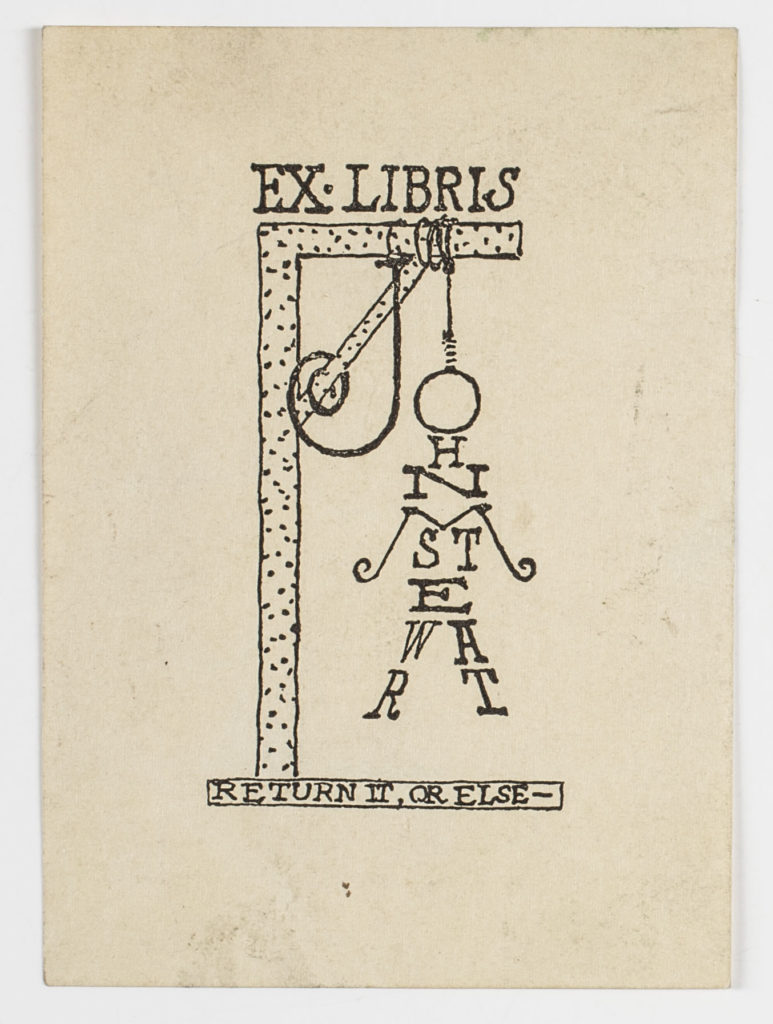 During our hunt for memento mori bookplates in the collection, we found several plates that were not necessarily focused on the loftier aspects of the brevity of human life. Most of these were along the lines of the unsigned plate for John M. Stewart, often threatening bodily harm, sometimes humorously, if books were not kept safe while out of their owner’s care. With a motto of “Return it,or Else,” this circa 1930s bookplate takes matters into its own hands: forget moralistic reflection, winged hourglasses, or skulls – just be sure to get the book back to Mr. Stewart in a timely manner!
During our hunt for memento mori bookplates in the collection, we found several plates that were not necessarily focused on the loftier aspects of the brevity of human life. Most of these were along the lines of the unsigned plate for John M. Stewart, often threatening bodily harm, sometimes humorously, if books were not kept safe while out of their owner’s care. With a motto of “Return it,or Else,” this circa 1930s bookplate takes matters into its own hands: forget moralistic reflection, winged hourglasses, or skulls – just be sure to get the book back to Mr. Stewart in a timely manner!

